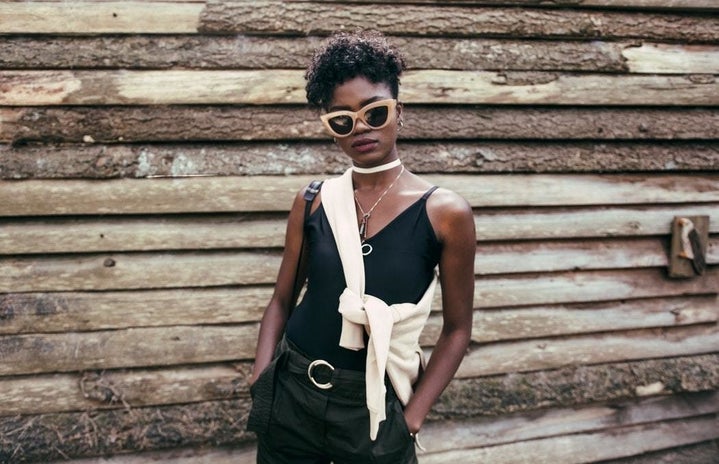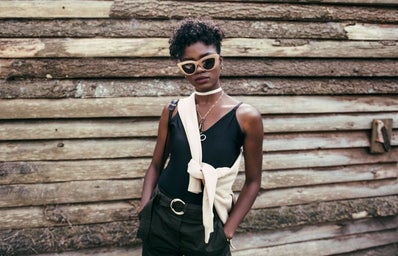Do you ever feel trapped in your own wardrobe? Are you ever stuck, feeling like you’re always putting together the same outfits? Or maybe you come up with new outfits, but you’re looking for a vision or direction that just isn’t there. Or maybe still, you love the outfits you create, but you love to try new things.
Allow me to present the Bumblebee Method.
I created the Bumblebee Method when I was in a major slump with my outfits. I felt like I was wearing the same thing over and over. I then spent some time crafting a template that would help me get out of that slump. I haven’t been bored since.
The idea is to take an aspect of nature, pull out its characteristics, and remix them in a way that doesn’t make it look like you’re wearing a costume. I call it the Bumblebee Method because the first outfit I ever created with this template was inspired by a bumblebee, but you can be inspired by anything from a clover to a sunrise to the planet Jupiter.
I’ll be walking you through the Bumblebee Method by creating three different outfits using it, each primarily focusing on one of my Style Roots, a useful system for settling on your signature style created by Ellie-Jean Royden. My roots are Mountain, the formal and powerful root, Flower, the delicate and intricate root, and Sun, the playful and experimental root.
Step 1: Settle on your focus.
As I already mentioned, we’re basing our outfit on a bumblebee, though you could base yours on anything you want. I’ve used multiple inspirations; roses, Orion, and a coral reef come to mind.
Step 2: Find the five most important characteristics of your focus.
Brainstorm what makes your focus special. For bumblebees, the most obvious things are stripes, the color black, and the color yellow. The others I’ll mention here are the wings and the stinger. I almost did fuzziness, but I don’t own enough fuzzy clothing to make that work.
Step 3: Translate non-clothing aspects into clothing characteristics.
Clothing doesn’t typically have wings or a stinger. Therefore, those have to be translated. The way I translated wings is light and airy, and the stinger is sharp and structured.
Step 4: Create your outfit—not a costume!
Look at these aspects individually and incorporate them into your new outfit. Here’s something important to note: black, yellow, and stripes do not mean to wear black and yellow stripes. You can, but you don’t have to. Each aspect is separate from the others. Here are the outfits I settled on, one for each style root:
Mountain:
- Yellow romper with loose, delicate pants — yellow, delicate
- Black belt around the waist — black, adds stripe illusion
- Black blazer with leather details — black, sharp/structured
- Black boots — black, structured
- Black, angular bow (I wear a bow every day) — black, sharp
- Black glasses — black
The Mountain outfit’s primary focus is the sharp, structured element, with a fair amount of black. This is also the most formal outfit.
Flower:
- Yellow sundress with floral pattern — yellow, delicate
- Black and white striped sneakers — black, light, stripes
- White bow — light
- Soft, light pink glasses — light
The Flower outfit focuses a lot on the light and delicate aspects of the template, with only a hint of black. The primary color here is the yellow of the sundress.
Sun:
- Yellow shirt — yellow
- Black jeans — black, structured
- Black and white striped cardigan — black, light, stripes
- Black ankle boots — black, structured
- Yellow bow with sun pattern — yellow, light
- Soft, light pink glasses — light
This outfit doesn’t focus on the Sun root as much as it could, but it doesn’t work as well given the template and the clothes I wear since Sun is my third root. I did my best. The primary focus here is the bold stripe pattern of the cardigan, which is accented by the simplicity of the other parts of the outfit.
Those are the three outfits! If I repeated any clothing items, I could have many more. The goal here was to make three outfits that were very different from one another while incorporating the same elements.
As you can tell, these outfits don’t look like bumblebee costumes. Since bumblebees have striking characteristics (yellow and black stripes), a person may conclude that one of the outfits is reminiscent of a bumblebee, but most inspirations would be more subtle than this one. A dragonfruit could be white, black, pink, polka dots, and layers. That would be far less obvious. So would a female cardinal being brown, red, pointed, rounded, and feathered. Pointed and rounded aren’t antonyms, but a dichotomy, and feathers can manifest as ruffles or soft things like fur rather than literal feathers (which they can also be!).
I hope that this system helps you, or at least gives you something to think about. You can also take it far less literally and add colors, but I was trying to go for the most literal route possible for example purposes.
Enjoy, bumblebees!


